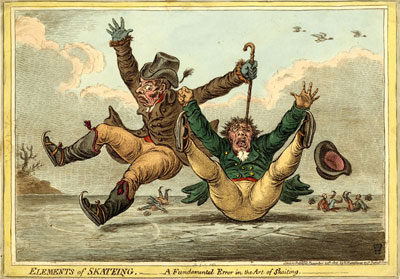Elements of Skateing:
A Fundamental Error in the Art of Skaiting
This is the third of a four-print series, Elements of Skateing, strategically scheduled for sale in late November as winter arrived in Britain, reviving the interest in (and possibility of) ice skating on lakes, ponds, and streams. If you haven't already done so, you may want to look at my Introduction to the series which provides some general background on ice skating as a sport and diversion, and its portrayal in paintings, prints, and drawings before Gillray.

A Fundamental Error in the Art of Skaiting
[November 24, 1805]
© Trustees of the British Museum
Comic caricature is full of accidents, pratfalls, and reversals—incidents which pointedly demonstrate that human control over circumstance is fragile at best; that nature in the form of an ill-concealed erotic desire, a misstep on a staircase, a runaway horse, a clumsy servant, a strong wind, a weak building structure, or a too energetic fire can suddenly and unexpectedly wreak havoc on human design, resulting in embarrassment, injury, or even death. But, as I've argued elsewhere,* comic caricature finds a way to deflect the pity or concern we might feel if the situation were real, and instead get enjoyment and amusement from it. Comic caricature does so, in most cases, by an unrealistic exaggeration of expression and by the proliferation of other pratfalls and incidents within the same frame preventing an emotional focus. Think of any number of Rowlandson prints where the eye moves from incident to incident scarcely ever settling on one.
In this print, A Fundamental Error in the Art of Skaiting , we can see some of those comic caricature techniques at work. The expressions on the two figures are, of course, exaggerated. The slipperiness of the ice has resulted in awkward and ungainly poses for both of them. One of them has lost his hat. The background figures provide additional examples of the embarrassments of skating which could act to deflect our sympathy. But in this case, the legs and arms of the central skater form a V which, instead of deflecting our focus, concentrates it like a funnel on the horrible image of the leftmost skater's stick being jammed into the hatless skater's eye. By adding this detail and putting it close to the very center of the print, Gillray has pushed the print towards what I have defined as grotesque caricatutre which, instead of reinforcing the safe distance between object and spectator, and creating detached amusement, begins to break down that distance, causing genuine discomfort.
* James Sherry, Four Modes of Caricature: Reflections upon a Genre
Sources and Reading
- Commentary from the British Museum on Elements of Skateing: A Fundamental Error in the Art of Skaiting.
- Rachel Knowles, "Ice Skating in Regency London," Regency History
- "Ice skating," Wikipedia
- "Ice Skating," Encyclopedia Britannica
- Robert Jones, A Treatise on Skating
- "Robert Jones (artilleryman)," Wikipedia
- Thomas Wright and R.H. Evans, Historical and Descriptive Account of the Caricatures of James Gillray #542.
- Thomas Wright and Joseph Grego, The Works of James Gillray, the Caricaturist; With the History of His Life and Times, p. 326.
Comments & Corrections
NOTE: Comments and/or corrections are always appreciated. To make that easier, I have included a form below that you can use. I promise never to share any of the info provided without your express permission.